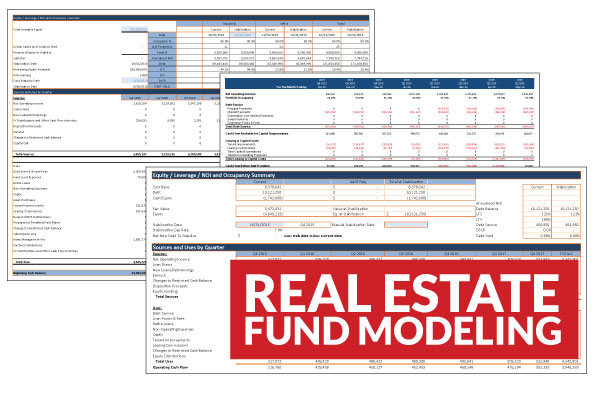Case Study: Real Estate Fund Modeling
Our Client came to us with multiple funds in various life cycle stages. At the time, each of these funds had a different Excel®-based Earnings Model that was used for investor reporting and asset management. Having their teams use these disparate models, which had been independently developed over the course of six years, was causing the Client to incur substantial costs both in time spent and productivity lost every time updates and reports were needed. There was no uniformity across the funds and worse yet, each Excel® model had different features, different functionality and different authors yet they all reported up to the same stakeholders and required the same Key Performance Indicators.
Technical and Real Estate Competence
The main sections each model was able to handle included:
- Importing Data from ARGUS® Valuation DCF or ARGUS® Enterprise
- Detailed Debt Modeling
- Financing Cash Flows
- LP Investor Waterfall Cash Flows
- Cash Balance Tracking
- Capital Calls
- Depreciation
- Required Distributions

After performing a thorough review of the Client’s Real Estate Fund Models in Excel® and their internal business process, CREModels developed a detailed scope to create a standardized Fund Model which could be used across all funds while also adding detailed debt modeling and other reporting features. The scope included extensive quality control, data population, and both forward and reverse testing on all of the funds involved.
The model took in both ARGUS® DCF and ARGUS® Enterprise data as the client was still using both platforms. CREModels has extensive experience in utilizing, manipulating, and repurposing ARGUS® data in all of its formats.
Historical data input and reporting features were added by CREModels which made the model immediately useful regardless of where a particular fund was its life cycle.
Internal and external operational and real estate data from providers like JD Edwards and Chatham Financial were incorporated to allow for both historical and pro forma modeling using real-world predictive data. CREModels has experience in modeling myriad loan scenarios and specific interest methodologies to re-create exact payment schedules in Excel® using a minimum amount of inputs.
The models also utilized the innovative CREBucketing™ process which allows structured underwriting of portfolios containing unstructured or disorganized income and expense data.
Customer Service
Throughout the entire process, CREModels worked alongside the Client’s internal team of analysts to facilitate unit testing, ensure the most efficient route to completion, and uncover issues prior to the firm-wide launch of the Real Estate Fund Model. One example of this methodology at work was handling differences between ARGUS® DCF and ARGUS® Enterprise as versions evolved to handle forecasting and updating the model with the newest ARGUS® runs.
CREModels created a custom training manual for the client for the firm-wide release and provided multiple training sessions to all analysts and stakeholders that were not involved in the product development team.
CREModels continued to work with the Client closely after the project to ensure all templates met quality guidelines and to assist with any issues on individual funds as they began their next analysis and reporting cycle.
If you’d like to learn more about how CREModels can optimize your business process through innovative solutions such as this, fill out the form below or contact us today!
Related Topics:
- Real Estate Financial Modeling & Analysis
- Real Estate Modeling with Microsoft Excel®
- Real Estate Underwriting Dashboards
